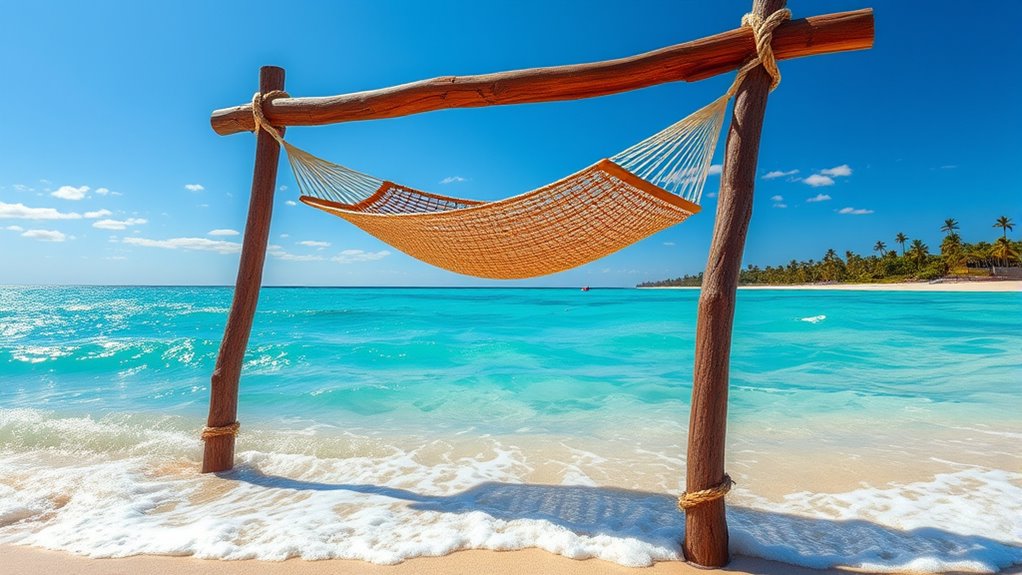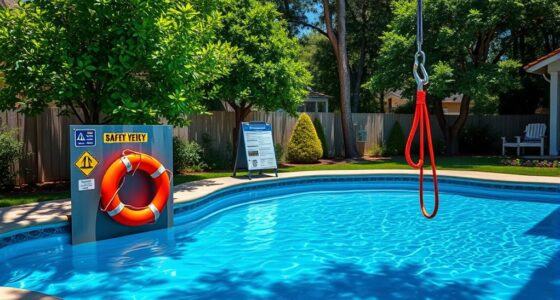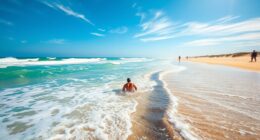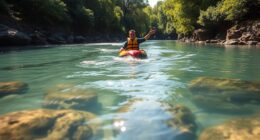To build a floating hammock at the beach, choose a buoyant type like inflatable, fabric, or mesh, and guarantee it supports your weight. Secure it to stable points such as buoys, boats, or docks with strong, corrosion-resistant ropes. Always check weather conditions and inspect your setup regularly for safety. Following these steps helps you enjoy a relaxing experience; explore further tips to keep your floating hammock secure and safe during your beach adventures.
Key Takeaways
- Choose a durable, water-friendly hammock type (inflatable, fabric, or mesh) suited for beach use and weight capacity.
- Identify stable anchoring points like buoys, anchored boats, or floating docks for secure setup.
- Use corrosion-resistant ropes or straps to attach the hammock firmly to the anchoring points.
- Check weather conditions and avoid setup during storms or high winds for safety.
- Regularly inspect and maintain the hammock and anchoring system, rinsing with fresh water after use.
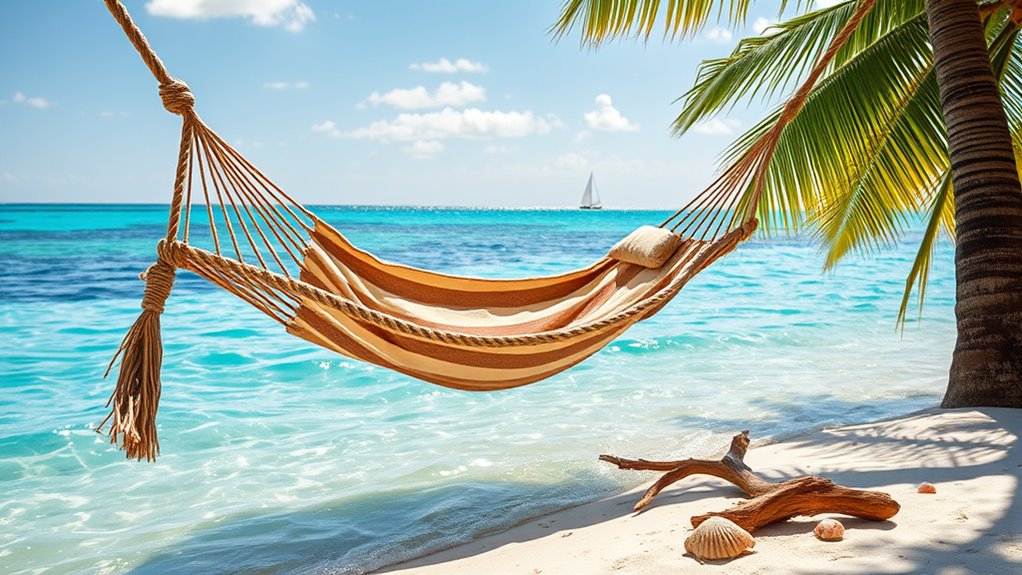
If you want to enjoy a relaxing day at the beach, building a floating hammock setup can be a perfect addition to your experience. The idea of lounging effortlessly over the water is appealing, but it’s essential to understand the different types of hammocks available and prioritize safety precautions to guarantee a fun and secure adventure. When choosing your hammock, you’ll notice there are several types of hammocks suited for floating setups, including inflatable, fabric, and mesh options. Inflatable hammocks are lightweight, easy to pack, and often come with built-in air chambers that provide buoyancy. Fabric hammocks, on the other hand, are usually made from durable materials like nylon or polyester, offering comfort and strength, but might require additional flotation devices. Mesh hammocks are great for breathability and quick drying, making them suitable for beach environments. Whichever type you opt for, make sure it’s capable of supporting your weight and is designed for water use.
Before you start building your floating hammock setup, it’s imperative to pay attention to safety precautions. First, always check the weight limits of your hammock to prevent any accidents. Never exceed the maximum capacity, and consider adding extra flotation devices if you plan to share the hammock with others. Secure anchoring is essential; use strong, corrosion-resistant ropes or straps, and ensure they’re firmly attached to stable points like large buoys, anchored boats, or specially designed floating docks. Avoid attaching your hammock to weak or unstable structures, as they could break or shift unexpectedly. Always test the stability of your setup in shallow water first, making sure it can hold your weight without drifting or collapsing. Keep a safety line or life jacket nearby, especially if you’re not an experienced swimmer, and never leave your hammock unattended in open water. It’s also wise to check the weather forecast before setting up; avoid building your floating hammock during storms or high winds, as these conditions can turn your relaxing day into a dangerous situation. Additionally, understanding the contrast ratio of your floating setup can help you choose materials that are more visible and safer in different lighting conditions.
Lastly, remember that floating hammocks require regular inspection. Over time, exposure to sun, saltwater, and wear can weaken ropes and fabric, increasing safety risks. Rinse your hammock with fresh water after each use, and store it in a cool, dry place when not in use. By understanding the types of hammocks suitable for floating setups and adhering to safety precautions, you guarantee your beach day remains enjoyable and safe. Whether you’re seeking tranquility or a unique way to relax, a well-built floating hammock can transform your beach experience into a memorable adventure.
Frequently Asked Questions
What Safety Precautions Should I Take While Setting Up?
When setting up your floating hammock, you should follow installation tips like checking anchor points and ensuring sturdy, secure lines. Always keep emergency preparedness in mind by having a life vest nearby and knowing how to quickly detach the hammock if needed. Avoid overloading it, regularly inspect for wear, and stay aware of weather conditions. This way, you enjoy your relaxing spot safely and confidently.
Can I Use Any Type of Hammock for Floating?
You can’t use any hammock style for floating, as material durability and design matter. Look for floating hammocks specifically made with UV-resistant, quick-drying materials like nylon or polyester, which hold up well in water. Traditional fabric hammocks aren’t suitable—they can become heavy and soggy. Choose a floating hammock designed for water use to guarantee safety and durability, so you can relax comfortably without worry.
How to Prevent the Hammock From Sinking or Drifting Away?
To prevent your hammock from sinking or drifting away, make certain you use secure anchor points and distribute weight evenly. Attach the hammock to sturdy, fixed objects or use specialized floating anchors to keep it in place. Adjust the tension so weight spreads evenly across the fabric, reducing the risk of sinking. Regularly check the anchor points and tension to maintain stability, ensuring a safe and enjoyable floating experience.
What Are the Best Materials for Floating Hammock Ropes?
For floating hammock ropes, you should choose marine grade nylon or polypropylene rope. Marine grade nylon is durable, resistant to UV rays and water, making it perfect for beach environments. Polypropylene rope is lightweight, floats easily, and resists rot and mildew. Both materials guarantee your hammock stays secure and long-lasting. Select the one that best fits your setup, considering ease of handling and strength requirements.
How Do Weather Conditions Affect the Setup’s Stability?
Think of your setup as a sail catching the wind; weather impact and wind considerations can make or break your relaxing experience. Strong winds or storms can destabilize your hammock, causing sways or even tipping over. Keep an eye on weather forecasts, and avoid setting up during high winds or storms. Adjust your ropes and anchoring points to counteract wind effects, ensuring your floating oasis stays steady and safe.
Conclusion
Now that you’ve built your floating hammock setup, you’re ready to drift away like a leaf on a gentle breeze. With the ocean as your backdrop, you’ll feel like you’re suspended in a dream, swaying softly above the water. This setup turns the beach into your personal paradise, where relaxation and adventure meet. So, kick back, embrace the sun, and enjoy the feeling of weightless bliss—your perfect escape is just a hammock away.

